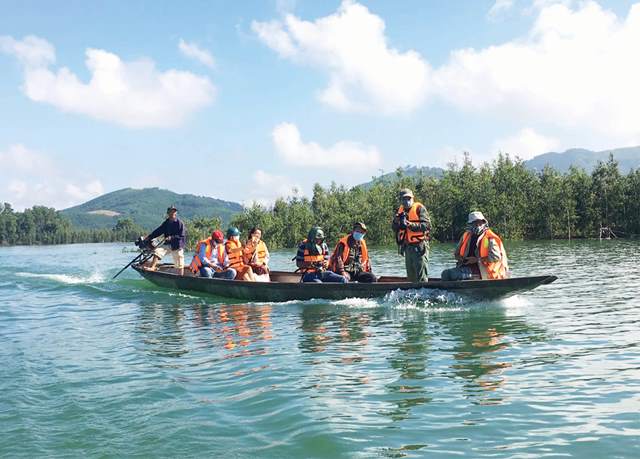
Touring on Binh Dien hydropower reservoir (Photo taken before the COVID-19 outbreak)
If we draw a picture of Mother Earth lying comfortably, resting her head on the mountain, then the hilly area represents her bosom. That place, in the past, was a fairyland. It is also a place where ethnic minorities live and pass on their unique cultural practices through generations. They were also the ones who initiated a revolutionary tradition, the ones who wrote the pages of history in the middle of the forest.
History of the hills
Present-day Hong Tien Commune (Huong Tra) was mainly first inhabited by the Pa Hy people, living in the low mountain forest, adjacent to the plain of Phong Dien district. From there, the land ascends to high mountains such as Tar Lang Ai, Vo Vo, Co Va, Da Dut, Doc Che, Mau Nha, Lim Lom, Coc Muon, Coc Kho, Coc Bai, Tar Roh, Doi Mang...
The most densely populated areas are around Tam Dan area, where the Tam Dan water gap upstream of Rao Trang is situated, and the Ala village upstream of Bo river in Phong Son commune, Phong Dien. In 1963, the Western Affairs Committee of Thua Thien decided to separate Hong Tien from A Luoi district. In 1990, Hong Tien commune was merged into Huong Tra town.
On the top of the hills of present-day Binh Tien region, we met the soldiers who once fought against the Americans: Commune Captain Nguyen Van Cao, Sergeant Am Poong Dai, Sergeant Major Pake Doan, Am Poong Bau… The stories told by the soldiers of the past were coherent and linked together like successive pages of history.
Like the story in 1955, Phong Dien District Party Committee advocated dividing the hamlets and villages to disperse the population so that the enemy would have difficulty in control. Or the story of the armed struggles, the silver-haired soldiers remembered most the battle against the raid in October 1960. When the enemy organized a big raid, the guerrillas coordinated with the armed forces to organize an ambush. By 3 a.m., the enemy was in sight. There were 2 who escaped, but the next day, Am Mit plotted to catch them when they went to the kitchen to beg for food...
.jpg)
Cage fish farming in the reservoir of Binh Dien hydropower plant
The process of settlement of Binh Dien commune took place in several phases. At the end of 1975, nearly 200 households in Huong Phong and Huong Vinh communes moved to Khe Dieng new economic zone. In 1976, this area was under Binh Dien commune’s jurisdiction. In March 1976, the Revolutionary People's Committee of Hue City mobilized 970 households with 4,361 people to live in Luong Mieu, Binh Dien. Gradually the commune became more and more populous.
In the process of formation and development, the Party Committee of Binh Dien commune has known how to exploit the inherent strengths of the locality to turn the commune into a grade 1 commune of the Huong Tra town.
New commune, new direction
From July 1, 2021, Binh Dien and Hong Tien merged to form Binh Tien commune. Chairman of Binh Tien Commune People's Committee - Nguyen Trung Kien commented: The communal merge offers many development opportunities. The expanded administrative boundaries will change the economy, increase the value of land use, create new industries and jobs... The economy will develop in a variety of ways, especially opportunities to promote local economic development and speed up economic restructuring, thereby attracting investment from businesses...
There has been prosperity since merging the communes. Binh Dien Market, a regional trade center, now helps Hong Tien farmers quickly sell agricultural products. Although the COVID-19 pandemic has had an impact, when conditions permit, the market is still vibrant with rich and diverse goods. Despite the pandemic, the service and trade sectors this year are still estimated at 80 billion VND, more than 61% of the plan.
Binh Tien's agricultural production is focusing on developing fruit orchards and is currently maintaining 45ha of valuable fruit trees such as oranges, green-skinned pomelos, thanh tra pomelos, rambutan... This year, people have shifted to fruit trees by 13ha, of which 9 ha for green-skinned pomelos, 2 ha for thanh tra pomelos, and 2 ha for Xa Doai oranges. They also planted an additional 20ha of acacia as a pilot, maintaining a total area of 1,640.5ha of planted forest, and 194.7ha of large timber plantations under FSC certification.
The industry and construction sector of the commune is developing sustainably. The value of handicraft production and construction in the whole commune in 2021 will reach over VND 56 billion… The commune currently has a policy for enterprises to build large-scale farms…
The program on building new rural areas has had stable and sustainable development. Binh Tien has achieved 15/15 criteria for new rural areas, per capita income has increased, the infrastructure system meets the production and living needs of the people, and the culture and environment are increasingly developing...
In the forest next to Mau stream, an orchid farm with an investment of many billions VND is being built. Soon, together with handicrafts, bamboo and rattan, green-skinned pomelo, and thanh tra pomelos, Binh Tien forest orchids will be exported. This will contribute to diversifying the types of goods in Binh Tien and promoting the development of the lush green hills…
Story and photos: Vo Trieu Son
